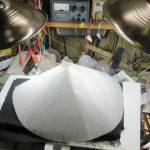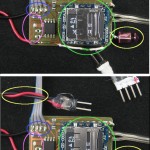 The standard way to get nice “professional” uniform lighting for technical photos is to use a “light box” with all white insides so light comes pretty uniformly from all directions. My plan for some time has been to build some kind of light box, and I finally got around to a first prototype. Turns out to be a cone rather than a box.
The standard way to get nice “professional” uniform lighting for technical photos is to use a “light box” with all white insides so light comes pretty uniformly from all directions. My plan for some time has been to build some kind of light box, and I finally got around to a first prototype. Turns out to be a cone rather than a box.
The setup
Cheap, simple and effective have been the requirements for this (as they most always are). I’d pictured a sort of hemisphere of maybe gauzy white cloth supported by maybe some kind of wire frame, with lights outside. I got as far as getting the lights a year or two ago, with two large metal reflector lamps with 100W-equivalent CFLs clamped on to a shelf above my workbench. The location was a compromise: I didn’t have room for the dedicated setup I would have liked, and the stuff I was photographing was often on the bench, and there was a shelf right there, so that’s (grudgingly) where the lamps went for the first pictures.
 But I found myself also turning the lamps on when I was working on delicate stuff on the bench and liking the additional light, so I slowly stopped begrudging their presence. They’re not pretty, but they’re functional, and they’re always right there for a quick picture. (And sticking the UV CFL in one for PCB exposures is really easy, too.) You can see them clamped on above the awful mess of my bench. The cutaway of the cone shows where the subject goes. The small hole for the camera lens shows up better in the top picture.
But I found myself also turning the lamps on when I was working on delicate stuff on the bench and liking the additional light, so I slowly stopped begrudging their presence. They’re not pretty, but they’re functional, and they’re always right there for a quick picture. (And sticking the UV CFL in one for PCB exposures is really easy, too.) You can see them clamped on above the awful mess of my bench. The cutaway of the cone shows where the subject goes. The small hole for the camera lens shows up better in the top picture.
Cheap or cheaper?
I recently ran across a post about using some LED rings from Deal Extreme (here and here at this writing) as ring lights for a camera. He used a sanded top from a cylindrical CD case for a diffuser. Looked great, and I could get the two 12V LED rings for about $13. Here was a no-brainer for getting the uniform light of a light box, right? Some assembly required (oh great – another project), and it requires 12V (but that’s easy to come by in the shop), and the extent of the light isn’t as large as a light box. Still pretty good. Go for it?
OK, I guess first I should do a quick revisit of possible implementations of an actual light box, using the actual lights I already have. The big bulbous hemisphere idea came up again, but in addition to not having a plan how to make it, storing and deploying/re-storing it came up, making it (once again) not a great solution.
I don’t remember how the tracing paper came up, but it seemed like a cone of translucent paper might work about as well as a box or sphere. I made up a quickie of three 9″x12″ sheets of tracing paper scotch taped together, with the bottom edge trimmed to about a circle. A line from apex to edge is 9″. I cut the apex off for a circular hole just big enough for the lens of my workhorse Canon SD600. Pretty flimsy, and that bottom edge might need a loop of wire attached to make it a little more stable (if less easy to fold up!), but it was quick and free. How well would it work?
Initial results
One of the perennial problems with pictures of PCBs (which I make a lot of!) is reflections of the traces. The copper is pretty, but it’s really hard to get uniform reflection off all areas of the board. (And getting no reflections is tricky as well.) My effective, but unwieldy solution is to use the great outdoors as a humongous light box. I take the board outside, find a place with a good view of uniform sky, stand so the board isn’t in direct sun, and move the board and camera until it gives good reflection of the large sky in the copper traces. A good light box should do even better. A populated PCB would be a great first test subject.
 Here are pictures with the two bare lights and under the cone. Four differences jumped out at me:
Here are pictures with the two bare lights and under the cone. Four differences jumped out at me:
The cover of the micro SD socket (green) gives a much more pleasant, uniform reflection in the cone (bottom) picture.
The PCB traces (pink) also give a nice reflection with the cone.
The reflections off the solder joints of the ribbon cable (blue) are pleasantly less harsh with the cone than with direct lights. I often have to mess with exposure to tone down such reflections.
Specular highlights on a piece of wire and the LED (yellow) are lost with the cone. The results are not too bad, but we lose the shininess of the wire and the LED. I like to have good, full-range pictures, but I like some sparkle, too.
So the cone gives noticeably nicer – I guess better – pictures, though maybe with a little loss of sizzle. I suppose if somebody were paying me for beautiful pictures I might poke a white LED or two through the paper for a couple of bright highlights, but they’re not, so I probably won’t.
So while I hate to lose the opportunity to justify some new toys (I sometimes wonder if the postman asks “Who is this guy and why does he keep getting all these little padded envelopes from China?”), I guess the tracing paper cone gives me the lighting improvement I wanted. And I owe the guy who did the light rings a thank you for forcing my hand and making me come up with an effective, free solution.

I have one of the 24 LED NeoPixel rings coming from Adafruit. Plan on making a tuneable ring light out of it.